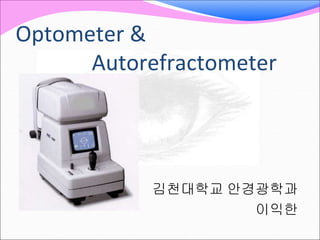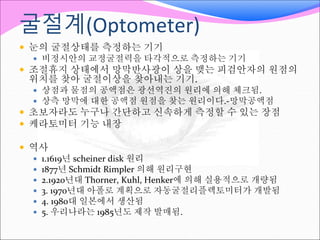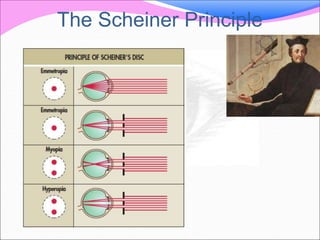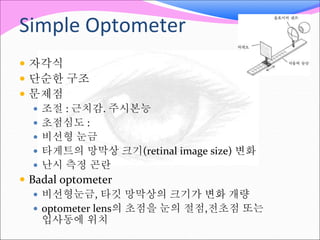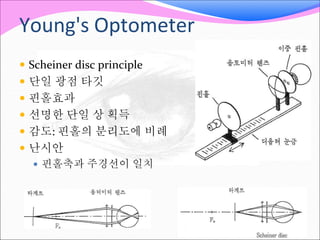Optometer
- 2. 굴절계(Optometer)  눈의 굴절상태를 측정하는 기기  비정시안의 교정굴절력을 타각적으로 측정하는 기기  조절휴지 상태에서 망막반사광이 상을 맺는 피검안자의 원점의 위치를 찾아 굴절이상을 찾아내는 기기.  상점과 물점의 공액점은 광선역진의 원리에 의해 체크됨.  상측 망막에 대한 공액점 원점을 찾는 원리이다.-망막공액점  초보자라도 누구나 간단하고 신속하게 측정할 수 있는 장점  케라토미터 기능 내장  역사  1.1619년 scheiner disk 원리  1877년 Schmidt Rimpler 의해 원리구현  2.1920년대 Thorner, Kuhl, Henker에 의해 실용적으로 개량됨  3. 1970년대 아폴로 계획으로 자동굴절리플렉토미터가 개발됨  4. 1980대 일본에서 생산됨  5. 우리나라는 1985년도 제작 발매됨.
- 4. 분류  자각식(subjective optometer  시표의 흐린 정도(blurred- ness)  선명한 정도(sharpness)를 판단 기준  타각식(objective optometer) : 망막으로부터 반사된 빛의 버전스 측정  결상식 : 타깃 상의 선명도  상합치식 : 타깃의 출사광선속의 광로를 둘로 분리시켜 망막에 결상
- 5. Simple Optometer  자각식  단순한 구조  문제점  조절 : 근치감. 주시본능  초점심도 :  비선형 눈금  타게트의 망막상 크기(retinal image size) 변화  난시 측정 곤란  Badal optometer  비선형눈금, 타깃 망막상의 크기가 변화 개량  optometer lens의 초점을 눈의 절점,전초점 또는 입사동에 위치
- 6. Young's Optometer  Scheiner disc principle  단일 광점 타깃  핀홀효과  선명한 단일 상 획득  감도: 핀홀의 분리도에 비례  난시안  핀홀축과 주경선이 일치
- 7. 타각식 굴절계  망막으로부터 반사된 후 눈을 빠져 나오는 빛의 버전스 측정  검영법  타게트의 상이 망막의 반사면 위에 선명하게 결상될 때까지 눈속으로 들어가는 빛의 버전스를 조정
- 8. Astron Refractometer  직상 검안경  조명계+ 가동 타깃  검사자가 타게트 의 선명도 판단  Optometer lens기준하여 타깃의 위치 가변  선명상이 관찰되도록 입사광선의 버젼스 변화  시도조절 필요  문제점  난시 측정 불능 할 수 없다.  상의 밝기가 양호하지 못하다.  각막반사  초점심도가 깊다.  검사 중 조절 하는 경향
- 9. Rodenstock Refractometer(PR-50)  망막에 집속된 타게트의 상을 관찰  도상 검안경을 이용 : 반사를 제거
- 10. 운용  시도조절 :접안렌즈  결상 :  관찰용 망원경 (observing telescope)과 프리즘 조정기(prism adjuster)연동  타깃상  문제점  상의 밝기가 양호하지 못하다.  환자가 측정시 조절하는 경향이 있다.  초점심도가 깊다
- 11. Hartinger coincidence optometer(Zeiss<Jena>  타깃상의 집속상태 확인 쉽다.  타깃을 두 개로 분리 경로 차
- 12. 타깃상 정 시 구면굴절이상 난 시
- 13. 적외선 굴절계(infra-red optometer)  가시광선 굴절계의 문제 : 조절 제어 부족  무조절 타깃 사용  장점  타깃의 버젼스영향 없다.  타깃의 조도변화 영향 없다.  단점 :  색수차 발생 : 원시화현상  적외선 변환장치 필요
- 14. 대표 측정 방법  Grating focus principle  Retinoscopy  Scheiner disc principle
- 15. 외관 및 각부 명칭
- 16. 활용  리플렉토미터  케라토미터  백내장검사를 위한 역광기능  가시홍채직경 및 동공크기측정  토포그라피  Rgp 곡률반경측정  PD
- 17. 광경로
- 18. 측정 광경로
- 20. 운무  타깃상이 흐려졌다가 다시 선명  운무렌즈 이동  관찰안으로가 움직였다가 챠트쪽으로 이동
- 22. 측정이 불가능한 경우  핀홀보다 적은 동공  눈의 매질이상  망막이상
- 23. 데이터 해석
- 24. ÏûîÏó¨Îǵ”ãú
- 25. AR의 장점  굴절검사의 속도 향상과 업무 효율성 제공  업무강도 감소  검사결과의 직접전송  정확성및 반복성을 제공  각막과 안구의 객관적 자료 제공  자각적 굴절검사의 시작점 제시  각막 분석 기구 포함
- 26. 1. EARLY SUBJECTIVE OPTOMETERS: o 피검사자가 직접 조작 o 피검자의 주관적 선택 o 조절의 영향이 크다. o 1.Badal Optometer 2.Young’s Optometer EARLY REFRACTOMETERS 1. EARLY OBJECTIVE OPTOMETERS: o 선명도 결정 : 검사자의 주관 o 검사자의 경험과 기술 필요 o optometer 원리, Scheiner’s 원리 사용
- 27. 초기 옵토메터의 문제점 1. Alignment Problems 1. 피검자의 협조 필수 2. 동공경 제한 Scheiner’s 원리 사용 2. Irregular Astigmatism 1. 핀홀 방향과 경선의 불일치 2. 경선별 타켓의 선명도차 3. Instrument Accommodation 1. 기계근시 발생 2. 조절유발 : 주의력, 피로, 주시 방향, 조도, 시표의 정밀도, 망막상의 선명도, 심리적요소
- 28. Modern refractometers Features Objective refractometers Subjective refractometers 광원 저조도 적외선 가시광선 소요시간 2-4 mins 4-8 mins 자료 형태 시력등의 부가정보 제공 불가능 (Humphrey 제외) 시력등 다양한 정보 제공 환자의 협력 의존 낮다.(>5 years) 환자가 직접 기기 조작 검사진행.(>8 years) Ocular factors 안매 매질과 황반부 질병정보 직접제공 간접제공 흐린 매질에서 작동 불가 기초자료 획득 가능 Over-refraction 곤란하다. 용이
- 29. BASIC DESIGN  적외선 광원  파장 800-900nm  기계근시 억제  망막 심부 반사  색수차 감소  0.75D – 1.50D 원시화  주시 타겟  주변부 흐린상: 조절이완  원치감 제공  Badal optometer  헤드에 구성  눈과 렌즈 간선형적 관계
- 31. Fogging  조절이완 방법  검사 중 흐린 타겟 이미지제공
- 32. 1. The Scheiner principle 2. The optometric principle (retinoscopic principle) 3. The best-focus principle 4. The knife-edge principle 5. The ray-deflection principle 6. The image size principle Modern refractometers 측정방식
- 33. Image Quality Analysis  Grating focus(best focus)  1970년 대 Dioptron 방식, R-l (Canon).  최고 감도의 optometer lens 최적 위치  회전드럼에 의한 광선 패턴과 출사광선의 패턴의 강도 일치
- 34. Scheiner principle  주사용 방식  동공에 2개의 LED광원을 사용  핀홀 : 광원과 대물렌즈의 초점위치  측정  Led를 이동 단일 이미지 생성  이동거리 : 굴절이상도  난시 : 4개의 Led사용
- 35. 1. Acuity Systems 6600 (NA) 2. Grand Seiko (RH Burton’s BAR 7, BAR 8 with AutoK) 3. Nidek (Marco’s AR-800 & 820, ARK -900 with AutoK) 4. Takagi Scheiner principle
- 36. Retinoscopic principle  격자(grating ), 슬릿(slit)원통 이용.  망막반사상의 이동 속도차와 방향차를 이용  이동 방향 검지식 : Baush & Lomb  속도 감지식 :Nikon NR-5500, Nikon Retinomax, Tomey TR-1000,Nidek OPD-Scan  Knife Edge principle  역진의 원리 사용  Welch Allen Suresight and Power Refractor II  Zeiss(humphrey) Hark 599
- 37. Retinoscopic principle - drum  수직 , 경사 슬릿 존재  개별 검지기간 감지 시간차 발생  수직 슬릿 : 수직경선의 굴절력 측정  경사슬릿 : 센서간 감지시간차 발생 이를 통해 사축의 굴절력 추정
- 38. WAVEFRONT TECHNOLOGY - ray deflection  Aberrometer  진화된 자동 굴절검사기 형태  눈의 여러 지점에서 의 빛의 굴절 상태 측정  광경로상의 파면 측정 (각막 수정체 매질 망막 )
- 39. WAVEFRONT TECHNOLOGY  광경로상의 파면 측정 (각막 수정체 매질 망막 )  고위도 수차와 저위도 수차로 인해 시력에 영향  기존 굴절검사기의 한계 극복  기존 기기 대비 정확  할로 현상, 수명현상, 야간 시력 저하 예측  새로운 타입의 안경 콘택트렌즈 처방 가능
- 40. PORTABLE AUTOREFRACTORS  소아와 자세고정이 불편한 환자에 적합  검사장소의 한계극복  기계근시 발생 제거
- 42. Subjective Autorefractor  Vision analyser:  비선형 광학계 사용  자각적 검사와 병행  SR-IV programmed subjective refractor  Optometer 원리 사용  Subjective autorefractor-7  구면 굴절이상 측정  Screening instrument
Editor's Notes
- #2: AUTOREFRACTOMETER
- #3: 1759년 옵토미터 용어 사용
- #4: The parallel rays of light entering the eye from a distant object are normally focused on a point on the retina in an emmetropic patient. They are limited to 2 small bundles when double pinhole apertures or a scheiner’s disc is placed in front of the pupil In a myopic eye, the 2 ray bundles cross each other before reaching the retina, and 2 small spots of light are seen. In a hypermetropic eye, the ray bundles are intercepted by the retina before they meet & thus again 2 small spots of light are seen.
- #9: 근접성 조절(proximal accommodation)로 알려진 반사성 조 절(reflex accommodation)이 작용한다. 두번째 환자는 타게트의 상이 망막에 집속되었을 때 선명하게 볼 수 있다는 점이 원인이다. 검사자가 무심코 타게트를 叩tometer lens와 너 무 가까와 지도록 이동시킨다면 환자는 타게트가 계속 선명하게 보이도록 조절할 것이며 또한 검사자는 계속하여 망막 위에 집속된 상을 보게 될 것이다. 검사자가 simple optome- tei■에 대하여 추천된 기술 즉,타게트가 선명하게 보일 때까지 흐려 보이는 위치로부터 optometer lens 쪽으로 점차적으로 타게트를 이동시키는 방법을 사용하여 조절로 인한 오 차를 최소화 시킬 수 있다
- #29: 1st line to speak Efforts have been made to eliminate limitations of old refractors:
- #31: Infrared light is collimated & passes through rectangular masks present in a rotating drum. The light passes through a beam splitter to the optometer system & is projected on the retina & a slit image is formed. The polarising beam splitter effectively removes reflected light from the cornea whereas the slit image from the retina passes through the polarised beam splitter and falls on the light sensor. The optometer lens system moves laterally to find the optimal focus of the slit on the retina. Optimal focus is achieved when a peak signal is received from the light sensor.
- #37: hawk
